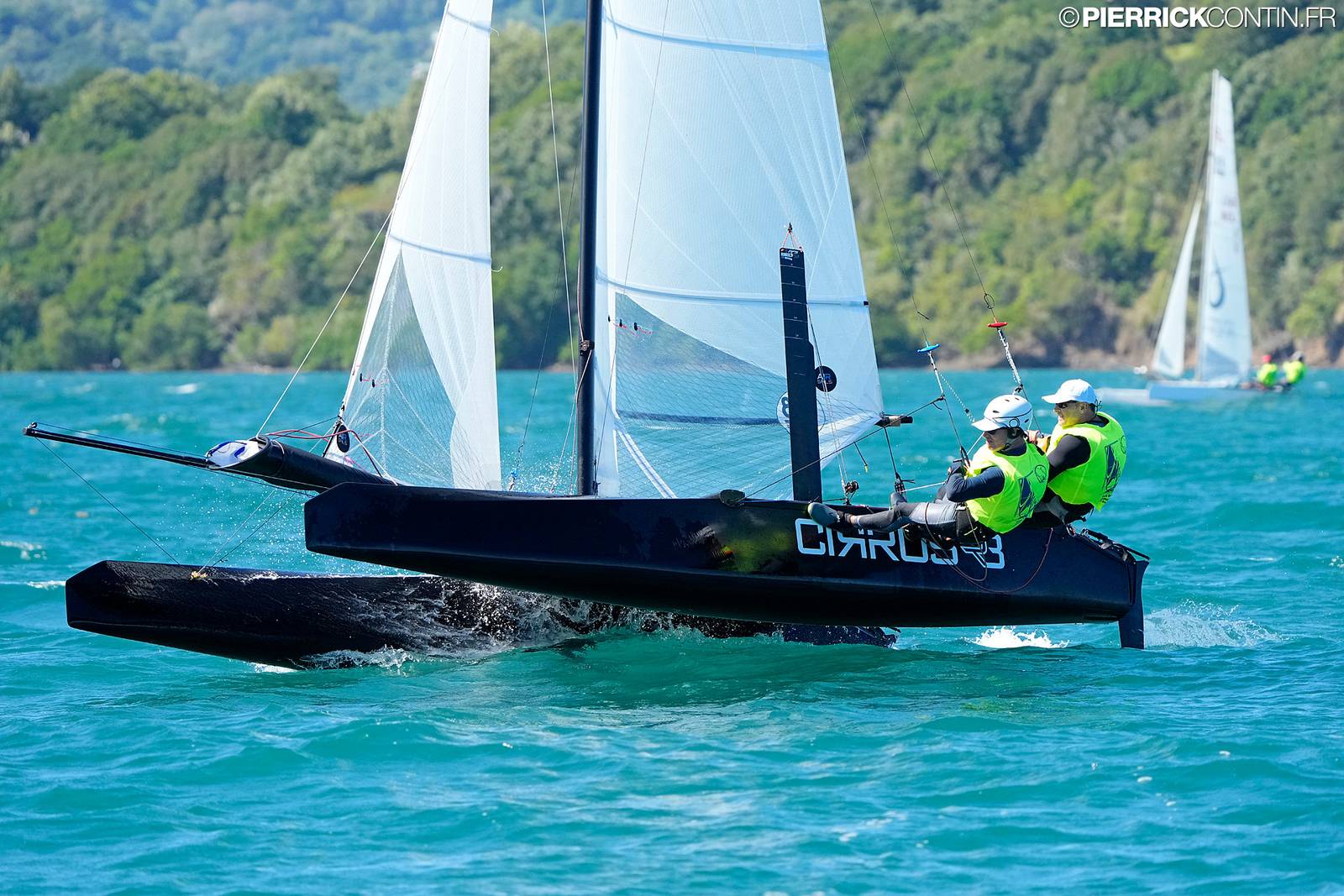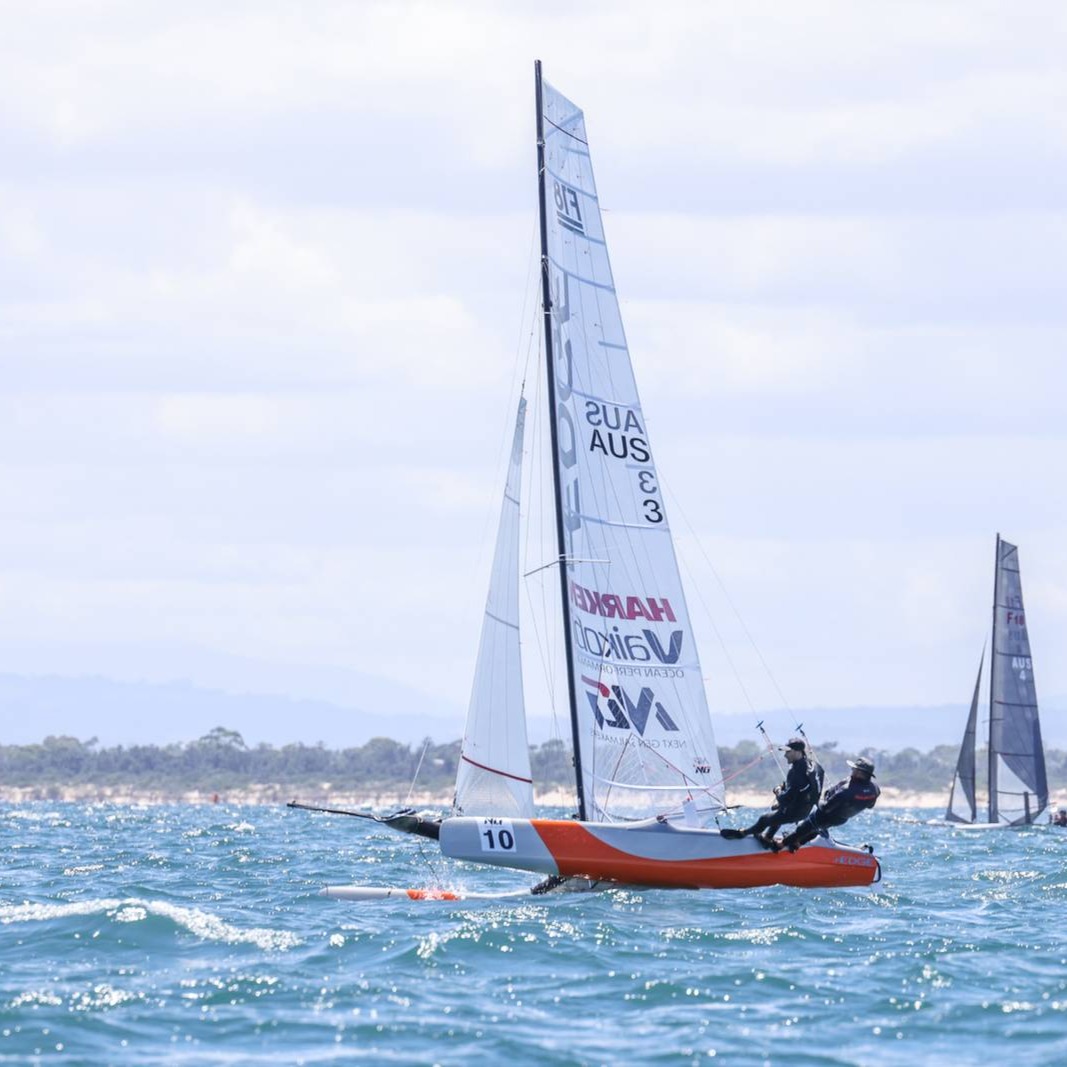A-Class: DNA 2016 ‘F1’: Coolest Sailboat Ever built
All Images by Holland Composites / DNA Click pics for HQ | —- Functionality & Looks pairing in such Weapon requires lots of investment and hard work. Huge congrats to PJ Dwarshuis , Mischa Heemskerk & Rudo Enserink and the Holland Compostites crew for delivering this outstanding piece of Craft / Art.
I received this material on Friday and later I showed the pics to the 3 local sailors who already purchased this new DNA ‘F1’. Their reaction was a plain “wtf!!?” & “m*!!” in the best way possible way you can think off along ‘incredible’, ‘awesome’ and many other exclamations of approval.
This boat is simply Off the scale, and to me it surpass any other sailboat ever made on the cool factor and the possibility to actually sail (in contrast to an AC72/AC45 Turbo etc), my own first reaction was “This indeed is an ‘F1’, a Ferrari” also thought of Arg Auto designer Pagani and his ‘Huayra’ & ‘Zonda’. (Which in fact are local God & Wind car names)
I knew it will look good when I made some renders out of some rough sketcthes they published, but they have trageted the full on package, Mischa, PJ & Rudo went Nuts designing & building this.
We’ll have time for additional comments, details and to see performance against the Exploder & Scheurer devels and if the aero refinements pay against their more Spartan platform, but taking out functionality & efficiency for a second (which is there just looking the video footage above plus the base platform & foils of the DNA 2015) & costs this is without a doubt the Coolest Sailboat ever built. WEAPON.
—————–
—————–
DNA A-Cat 2016 ‘F1’
Our company will be celebrating 25 years by the end of this year and it’s 35 years ago since PJ – one of the founders – built his first A-Cat (and has never left the class ever since). So we thought the moment was there to use all our knowledge and experience, and get to work on the very best A-cat platform we could think of. This is the result; the DNA F1.
We knew that the previous platform, which has run from 2010 until 2015, was pretty much at the end of its design life as it was restricted in some ways concerning further improvement. After Punta Ala we set up a team to just consider new ideas and design directions. That design team was again Pieterjan Dwarshuis, Mischa Heemskerk as invaluable source of info and Rudo Enserink as designer; all and all the same guys responsible for the G4). By November we had a pretty solid idea of what we could realize and decided to make the jump and invest in a new platform. What you see on these pictures is the result of basically 6 months flat out design work, testing, tweaking and production work. We have now done our homework and will start delivering to customers as of next week.
I cannot put it any other way; we went to town for this job.. so many ideas, so many CFD checks, so many difficult goals. What we pulled off in the end is in our opinion a very high quality, high-spec boat. Obviously the main driver was to develop the ultimate optimized boat, and optimized within the class rules. Pictures paint a thousand words but we would like to shed a light on what everyone will see when looking at attached pictures. If you look at the vid, do not mind the shaky footage.. If you think about it, you will be pleased to see we have spent the money on engineering and tooling rather a pro gimballed piece of camera (it is on the agenda though).
Aero
The 2016 boat is new from the ground up and optimized for extremely low windage . With the speeds we reach both upwind and downwind nowadays, aero drag is a serious factor. If you keep in mind that the total driving force resultant upwind is approximately only around 150 Newton, then you understand that in a situation where the boat is doing 13 knts upwind in a 17 knts TWS, the apparent wind is 30 knts. Coming from a country where cycling is the norm, we love to compare with riding a racing bicycle at 55 km/hr; anyone having tried so will understand the importance of windage very quickly. Our answer to that topic is found partly in the new overall sleek design and an extremely streamlined soft deck (it is no longer a traditional trampoline). The main beam and rear beam have been integrated in the airfoil section, the tiller bar and tillers have been integrated in the airfoil section too and lastly we have a fully recessed traveller track.
Stiffness & lightness
Apart from aero, the platform should be class leading in construction too. We were pleased with the previous model but the new boat is truly optimized for ultimate stiffness and lightness. Now this is for the tech savvy people; its hulls are made in one single production run (so not the traditional two halves laminated together) in the autoclave which allows curing under high pressure and high temperature. As a result there is no secondary bonding, and no bonding lines. The hulls weigh in at 11.5 kg each with high fiber content hull skins at 300 gsm. The airfoil shaped beams are cured in the autoclave too. The standard finishing for the DNA F1 is clear coated carbon, as this is the lightest finishing possible (painting in colour on request).
Foiling
The new design is designed for flying from the very start, opposed to the previous generation platform which evolved into one. We have a new beam and foil positioning with a bigger span between rudder and main foil. The foils have been subjected to optimization with minor improvements and we have a completely new rudder head design which brings drastically improved stiffness due to the bigger span of the gudgeons. Longer tiller arms allow for more precise steering and a completely integrated ‘belt drive‘ rake system on the main foils offers accurate adjustment. The hull shape is optimized for trapezing while flying with an ergonomic hull height in the rear. As last the boats width is optimized for trapezing by giving max beam where practical only.
Light wind conditions
We believe the new platform provides a vast improvement in light wind ‘drifting’ conditions, we noticed this should be improved from the previous generation. Rocker has been increased, the bow is finer and the new hull shape also includes an optimized indented area around the daggerboard lower exit to avoid excessive drag. The new kinked front beam is ergonomically spot on for good downwind flat positioning and steering.
Best,
Thijs van Riemsdijk
Holland Composites BV | De Serpeling 10 | 8219 PZ Lelystad | The Netherlands
T +31 (0)320 281 877 | [email protected] | www.hollandcomposites.nl
———————————
———————————
PJ comments:
But this time I am very proud of the result of the new DNA F1.
Since the first flights on the A class , back in 2013, we worked pretty hard on trying to get the A Class on the next level and especially worked on how to control the boat better during flying .
Quite quickly in this development I realized that keeping the rules as the are was far out the best option for the A class.
You can sail from the beach , in shallow waters , launch the boat easily . Sail fast from 2 knts till 25 knots, just by adjusting the settings .
You need good skills to fly like Ashby or Heemskerk , but that is just the same as by windsurfing or kite surfing .
The new DNA is developed by the DNA design team of myself , Mischa Heemskerk and Rudo Enserink , the same team as did the G4 big brother .
Last year with did a prototype and tested several new ideas , some of them failed , some of them really made a big difference .
I spent a lot of time on the water with Mischa , who is without any doubt one of the most talented sailors around and has a professional technical background too.
Making the boat better is not just changing one thing , it is a big number of small details which makes the result.
Composite production technique, aero design,total layout, daggerboard and rudder design and controls, stiffness, balance etc etc.
I am especially thankful to my partners in Holland Composites , Sven erik Janssen and Thijs van Riemsdijk, who tolerated and backed my addiction to built the coolest boat on the planet -again –
**For distributing name source DNA/Holland Composites / Catsailingnews.com














































I just heard that my great sailing friend and former CEO of Hobiecat Europe has passed. May The endless oceans…
...Report was sent by an F18 Sailor, if you want Hobies reported send your own, we'll publish as usual. Cheers.
Looks like in your report the Hobies are not really present. Suggest to rewrite the article.
Thanks for the great report Wik. Great battle.
If I correctly read the results the overall winner this year is a Hobie16